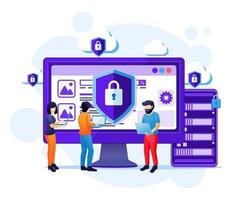 Blog's Page
Blog's Page

In A World Where Our Lives Are Increasingly Entangled With Technology—from Finances And Communication To Entertainment And Work—the Need For Airtight Home Computer Security Has Never Been More Vital. Cybercriminals Are Constantly Refining Their Techniques, Making Even The Most Casual Home User A Potential Target. Fortunately, There Are Several Proactive Steps You Can Take To Ensure Your Personal Information Stays Safe.
Here’s Your Essential Guide To Enhancing Home Computer Security, Packed With Practical Insights And Expert-level Advice.
Updates Aren’t Just Cosmetic—they Often Patch Known Vulnerabilities That Hackers Can Exploit.
Enable Automatic Updates For Your Operating System (Windows, MacOS, Linux).
Regularly Update Browsers, Apps, And Antivirus Software.
Don’t Ignore Firmware Updates, Especially For Routers And Other Connected Devices.
? Pro Tip: Set A Weekly Reminder To Manually Check For Updates On Devices That Don’t Auto-update.
A Weak Password Is Like Leaving Your Front Door Unlocked. Don’t Make It Easy For Attackers.
Create Passwords With At Least 12 Characters, Including Letters, Numbers, And Symbols.
Never Reuse Passwords Across Accounts.
Use A Reputable Password Manager To Store And Generate Secure Credentials.
? Example: Replace “password123” With Something Like “M$7vKp2&x!qL9wZ”.
2FA Adds An Extra Layer Of Security By Requiring Something You Know (your Password) And Something You Have (a Mobile Device Or Authenticator App).
Activate 2FA For Email, Cloud Storage, Banking, And Social Media Accounts.
Prefer Authentication Apps Like Google Authenticator Or Authy Over SMS.
? Bonus Tip: Always Keep A Secure Backup Of Your 2FA Recovery Codes.
Malicious Software Can Lurk On Websites, Email Attachments, Or USB Drives—ready To Hijack Your Data.
Choose Trusted Software Like Bitdefender, Norton, Kaspersky, Or Malwarebytes.
Run Periodic Scans To Detect Dormant Threats.
Turn On Real-time Protection Features.
? Warning: Avoid Pirated Versions Of Antivirus Software—they Can Ironically Be Malware.
An Unsecured Wi-Fi Network Is An Open Invitation To Cyber Intruders.
Rename Your Network SSID To Something Generic (avoid Using Names Or Addresses).
Use WPA3 Encryption (or WPA2 If WPA3 Isn’t Available).
Set A Strong Router Password—not The Default “admin/admin”.
Disable WPS, Remote Access, And UPnP If Not Needed.
?? Check Your Router Settings By Typing Its IP (usually 192.168.1.1) Into Your Browser.
A Firewall Blocks Unauthorized Access While Permitting Legitimate Communication.
Most Operating Systems Have Built-in Firewalls—ensure They're Enabled.
Consider An Additional Hardware Firewall For Extra Protection, Especially If Running Servers.
? Fun Fact: Some Modern Routers Offer Built-in Firewall Features—explore Those Settings.
Phishing Attacks And Malicious Downloads Are Among The Most Common Ways Systems Get Compromised.
Don’t Click Suspicious Links Or Open Unexpected Attachments.
Verify Sender Identities, Especially If They Ask For Sensitive Info.
Download Software Only From Official Or Well-known Sources.
? Hover Over Links Before Clicking To Preview URLs—watch Out For Misspellings Or Strange Domains.
Sharing A Computer At Home? Don’t Give Everyone Admin-level Access.
Create Separate Accounts For Different Users.
Use Guest Accounts For Temporary Access.
Restrict Admin Privileges To Trusted Users Only.
? This Limits What Damage Can Be Done If One User’s Account Is Compromised.
Your Computer Doesn’t Operate In A Vacuum—smartphones, IoT Gadgets, And Even Smart TVs May Share Its Network.
Regularly Update Firmware On All Connected Devices.
Enable Device-level Encryption Where Available.
Change Default Passwords (especially For Devices Like Smart Cameras Or Thermostats).
? If Your Smart Light Bulb Is Vulnerable, Your Entire Network Could Be Too.
Even The Best Security Setup Crumbles If Users Aren’t Informed.
Stay Updated On The Latest Scams And Security Trends.
Teach Kids The Basics Of Online Safety.
Encourage Secure Habits—like Logging Out Of Accounts And Avoiding Public Wi-Fi For Sensitive Tasks.
? Consider Subscribing To Cybersecurity Blogs Or Newsletters For Bite-sized Updates.
Backups Are Lifesavers: Use An External Hard Drive Or Cloud Service To Back Up Critical Data Weekly.
Use A VPN: Encrypt Your Internet Traffic—especially When Using Public Wi-Fi.
Limit Webcam And Microphone Access: Turn Them Off When Not In Use Or Block Apps That Request Unnecessary Access.
Physical Security Matters Too: Lock Your Computer If Unattended, And Store Sensitive Drives Securely.
? Security Isn’t A One-time Setup—it’s A Lifestyle. Like Brushing Your Teeth, You’ve Got To Stay Consistent.
Home Computer Security Isn’t Just For Tech Experts—it’s Essential For Every Internet User. With Digital Threats Constantly Evolving, Your Best Defense Is Layered Protection: Software, Habits, Awareness, And Proactive Thinking.
By Following The Steps Above, You’re Not Only Protecting Your Data—you’re Safeguarding Your Identity, Your Finances, And Your Peace Of Mind. So Take The Time, Do The Updates, Strengthen Your Passwords, And Become The Master Of Your Digital Domain.
Enhance Home Computer Security, Home Computer Security